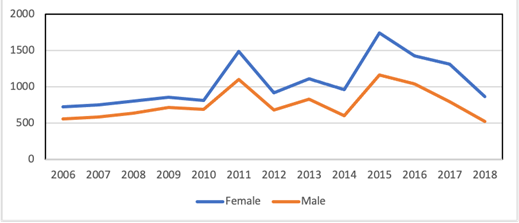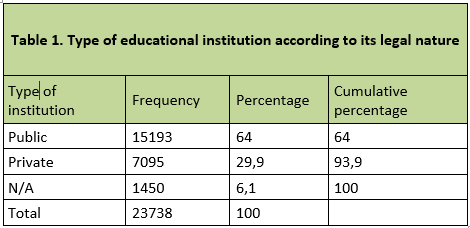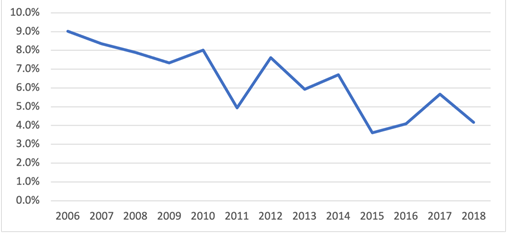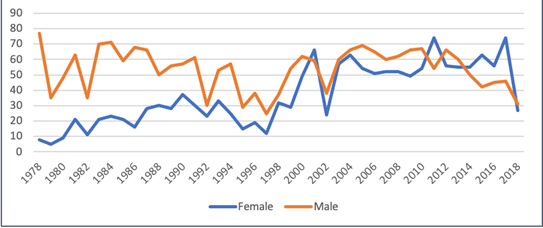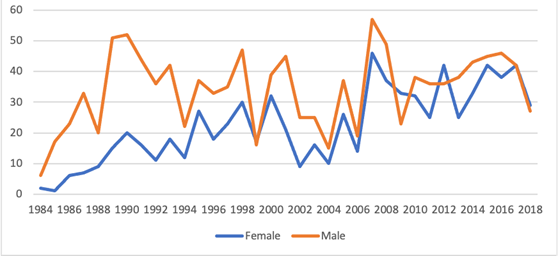Introduction
Since ancient times, educating doctors has been one of society’s main concerns. With the creation of universities in Europe in the 12th century, the necessity to certify the suitability of graduates with a diploma representing successful completion of the educational process arose. In 1180, for the first time in history, the University of Salerno Medical School awarded a diploma allowing the practice of medicine. Also, for the first time, regulated education was established, with a program, teaching method, and curriculum. In addition, the translation of classical texts that the school itself began to compile made it possible to turn what was considered a trade into a profession at the time 1. In the American continent, the first university was founded in 1538; and forty years later the Chair of Medicine was established at the Royal and Pontifical University of Mexico 2. Already disassociated from the church, today it is the State that regulates the creation of medical schools and defines the quality criteria for student education 3.
The World Medical Association (WMA) defined the practice of medicine as a dynamic process of permanent evolution in which new advances in technology and new discoveries for diagnoses and treatments are constantly appearing 4. The Institute for International Medical Education (IIME) defined the domain and competences that a graduate should have, related to professional values, aptitudes, attitudes, good behavior, ethics, scientific foundations of medicine, social communication skills, clinical skills, knowledge of population health, health systems, information management, logical thinking, and research and technology 5.
In Colombia, the Ministry of Education has delegated the responsibility of ensuring the quality of medical instruction throughout the education process to medical programs with official registration. The goal of medical education is to train ethical and competent physicians to ensure optimal patient care 3.
These particularities of the medical degree expose its applicants to a heterogeneous and transdisciplinary scenario that demands vocation, adequate prior knowledge, and a firm stand. For this reason, many medical programs strive to define a profile and conditions for admission that will ensure students have the intellectual and ethical qualities needed to successfully graduate.
The characterization of students in a medical program is a relatively understudied process as part of a comprehensive curriculum evaluation 6. In fact, few publications consider the demographic and academic conditions of students at the time of entry and graduation, their impact on the curriculum and life of students entering college in early adolescence. Students are often subjected to prolonged academic, psychological, and social demands. The association between these demographic variables and academic performance is not very clear, since this is the result of a multiplicity of factors related to the student (personal, family), social, and to the institution and its teachers 7)(8.
Most higher education accreditation agencies recommend the creation and implementation of follow-up programs for their graduates 9 with little emphasis on defining admission profiles. In this regard, knowledge of the sociodemographic environment of students beginning their studies is fundamental when planning interventions within programs, designing curricula that are more adjusted and pertinent to the needs of society, and measuring the impact and efficiency of the use of educational resources.
The Colombian Association of Universities (ASCUN) has recommended its affiliated institutions carry out research that characterizes students, including socioeconomic, demographic, and academic aspects, among others, in order to identify the determinants that influence their development within the university environment 10. However, there is relatively limited literature that delves into the relationship between the students´ conditions and their academic performance.
Some medical programs in the country have used state test scores as their sole selection criteria. A study like the one presented is an input for academic reflection on the admission profile and the components (cognitive, psychological, social, attitudinal, etc.) needed to be admitted to a medical program.
The Medical Program at the Universidad Tecnológica de Pereira started in the year 1977. The only requirement for entry into the program is the state test score (ICFES - Pruebas Saber 11). The duration of the curriculum is 13 semesters, including the internship year. In addition, the future physician must meet second language proficiency requirements and take the State exam (ECAES Pruebas Saber Pro). Compliance with these tests leads to the title of Physician 11. Today, the program has high quality accreditation, and 57 authorized spaces in its Qualified Registry, of which 5 correspond to minorities, and 2 are for internal transfers. Of the 38 spaces remaining, 70% are for the municipalities of Pereira and Dosquebradas and 30% for the rest of the country.
This research describes the sociodemographic and academic characteristics of the students in the Medical Program at the Universidad Tecnológica de Pereira during the period from 1977-2018. The results will allow the University and the Faculty of Health Sciences to review their strategies for enrollment, admission, and monitoring of students entering the Medical Program.
Methodology
The present is an observational, cross-sectional, descriptive study characterizing students of the Medical Program at the Universidad Tecnológica de Pereira during the period from 1977-2018. No sample was calculated. All records of students who applied, were admitted, enrolled, and who graduated from the program in the described period were included.
The information was obtained from the database of the Office of Admissions, Registration, and Academic Control at the Universidad Tecnológica de Pereira. For the group of applicants admitted, enrolled, and graduated, information was gathered starting from 1977. The University only has information on applicants since 2006. The data was recorded in an Excel database and then loaded into Strata V15 software for processing and analysis. A univariate analysis was done with measures of frequency, ratios, rates for qualitative variables (nominal or ordinal) and measures of central tendency and dispersion for quantitative variables (interval or ratio). Assumptions of normality for quantitative variables were tested. The bivariate analysis included a dependency ratio between qualitative variables through chi-square and parametric statistics (t of student, anova) for the quantitative variables that met the assumptions of normality or non-parametric statistics (U of Man Whitney - Kruskall Wallis) for those that did not.
Results
Applicants
The University has information on program applicants as of 2006. Since that year and until 2018, a total of 23,738 people have applied for the Medical Program. In relation to socioeconomic stratum, the highest percentage corresponds to lower strata, (61.8%) including Low-low (11.7%), Low (35.8%) and Lower-middle (26%) strata. The upper strata represent 5.7% of the total number of applicants.
Women represented 58.1% and men 41.9%. This predominance of females is maintained throughout the period observed (Figure 1). The average age for female applicants was 18.7 years (SD 2.5) and for men 19.4 years (SD 3.6). These differences were statistically significant (p<0.05). (Figure 1)
In terms of origin, Risaralda ranks first (40.4%)(9598), followed by the departments of Valle del Cauca (15.9%)(3765) and Nariño (15.4%)(3655). 80.5% of applicants come from 5 departments (Risaralda, Valle del Cauca, Nariño, Caldas, and Cauca).
Pereira is the municipality with the highest percentage of applicants (23%)(5585), followed by Dosquebradas (7.8%)(1849). Within the group of municipalities other than Risaralda, Pasto has the highest number of applicants (4.7%)(1118). 64% (15193) of the applicants came from public institutions. One in every three applicants comes from a private school (Table 1).
Enrolled students
From 1978 to the 2018 (first semester), a total of 3714 students enrolled. If we take the number of students enrolled from the year 2006 (1432) in relation to the number of applicants from the same period (23738), the average acceptance rate is 6% and has a tendency to decrease to 4% in 2018, which means an applicant/enrolled ratio of 25 to 1 and an unsatisfied demand of 96% (Figure 2).
Since 2000, there has been an increase in the number of places assigned to the program with an average of 113 students enrolled per year. Of the students enrolled, 40.6% (1507) are female and the percentage of admission grows over the years, from 30% to above 50% in the last periods. The medians for men and women were 18 and 19 years old, respectively (p<0,05) (Figure 3).
In relation to the department of origin, Risaralda is in first place (68%)(2540), followed by Valle del Cauca (19.8%)(284) and Nariño (19.7%)(262). Of those admitted, 60% are from the coffee region (Caldas, Quindío, and Risaralda). Regarding municipalities of residence, 50% of the enrolled students come from Pereira. Together with Dosquebradas and Santa Rosa de Cabal, they account for 60.5% of enrolled students. The rest of the municipalities in the country have percentages lower than 3%, with Pasto having the highest percentage of enrolled students, 2.8%, of municipalities outside of the department of Risaralda. Public schools predominate with 61% (637) compared to private schools (39%)(415).
Graduated Students
Of the total of students enrolled in the period (3714), 53% (1984) graduated. There is evidence for male genre in the first few years, a trend that has been reversed since 1998 (Figure 4).
There is a decreasing trend in the number of years studied, with a median of 13 semesters and an interquartile range between 12 and 15 academic periods (Figure 5). The average age of graduates is 26.5 years old and the overall average time to complete the program is 7.4 years.
In the distribution by gender, women graduated in less time (7.3 vs 7.5 years), at younger ages (25.9 vs 26.8 years) and enrolled in fewer academic periods (13.7 vs 13.8 periods) compared with men. Although students who attended private high schools completed the program in a shorter time (7.31 vs 7.48 years), enrolled in fewer academic periods (13.54 vs 13.87) and graduated at a younger age (26.15 vs 26.63), these differences were not statistically significant.
Non-graduates
For the first semester of 2018, there were 711 students enrolled, which represents 41% of the total non-graduates (1730). Of this subpopulation (1019), 636 (62.4%) only enrolled once during the entire study period (definitive dropout) and 342 (33.5%) have not enrolled for less than 6 years (average 2.6 years) and 42 students have not enrolled for more than 6 years (average 10 years). The majority of this subpopulation are men from the department of Risaralda, from public schools.
Discussion
The results presented in this publication cover the period from 1977-2018, and differentiate between the applicant, enrolled student, and graduate. From these three population groups, sociodemographic variables were crossed that allowed us to know the type of student, their origin, and the time they invest in studying medicine, among other variables. Studies such as the one presented in this article have been replicated in other countries in an attempt to design more reliable indicators of academic performance, regularity and graduation, among others 12. Some demographic characteristics such as background, social, family, economic factors, students working and studying, etc. have been associated with the academic performance of medical students during their study period 8)(13)(14. In Colombia, the concern for characterization studies in university students is not new 15)(16)(17)(18.
Within the group of demographic variables studied, the age range found (17-21 years) was similar to that of Amoros 19 and slightly lower than that reported by Caro 20, within the range of 20-25 years. Kim 21 reports a significant association between younger age of entry and better academic performance. In this study, females had fewer periods of enrollment (13.7 periods) and reached graduation with a lower average age (25.9 years) when compared to men.
Regarding gender, this study confirms the global trend towards an increase in the number of women in universities and particularly in medical programs 22)(23)(24)(25. The percentages reported are Amoros (74.8%) (19), Campillo and Paéz 60.6% 26, Rodríguez 56% 27 and those reported by the ASCOFAME study for the period 2014-2018 in which women accounted for more than 60% of first-year enrollments 28. Only the Rocha study reported different information, with a percentage of women less than 40% 29. This increase is consistent with the development of public and educational policies of equity, better fertility control, greater emancipation of women, and a change in traditional roles, among others.
Similar to what has been shown in studies of public universities, a high percentage of enrolled students belong to socioeconomic strata 2 and 3. Caro’s study 20 at the University of Antioquia, shows a predominance of students belonging to stratum 3 (40.6%). In this study, the cumulative percentage of students from low and lower-middle strata is 62%. This result was not associated with a longer stay at the university. In contrast, Cardozo 30 compared two universities in Venezuela and Spain, finding that 46.4% and 68.9%, respectively, were classified as upper-middle class. Moreno 22 reports similar results in a private university with 69.9% of its students in strata 4, 5, and 6.
Fayolle 31 reported a significant correlation between parents’ socioeconomic stratum, type of secondary education (public or private) and students’ academic performance. In this study, students come mostly from public schools (61%). Students from private schools were enrolled for fewer academic periods and graduated at a younger age. However, this difference was not statistically significant.
In terms of origin, consistent with its status as a national public university, students from all over the country apply and enroll. The regional and municipal environment predominates as more than 60% of the enrolled students are from departments in the coffee region, and half of the students come from the municipality of Pereira. Dhalla et al. 32 in their study in Canada, emphasize the need for program students to adequately represent populational diversity as a strategy for future graduates to return to their place of origin and reverse the excessive concentration of physicians in the urban area.
Furthermore, the ratio of applied/enrolled students (25:1) is concerning, much higher than the ratio reported by Fernandez et al. of 16.9 applicants for each admission 9, and much more so if compared with the data from the Ministry of Health for the 2010-2016 period (7.45:1) or the Colombian Association of Medical Schools (ASCOFAME) of 6.9:1, for public universities in 2016 33. This unsatisfied demand for admission merits a discussion by the region’s authorities; even more so if the growth in enrollment observed in recent years has been marked by private universities that have attracted more than three-quarters of the new students 28.
Respecting the enrolled/graduate ratio, the Colombian Ministry of Health reported data for the 2010-2016 cohort with a graduation rate of 85% 34. This growth in the number of graduates at a national level is greater in private universities, being responsible for 96% of the increase in the number of medical graduates at a national level in the 2014-2018 period 28. In contrast, this study found a graduation rate (not adjusted by cohorts) of 53% (1984).
Respecting non-graduates (1730), they represent 27.4% of the series studied, excluding active students (711). Of the total students enrolled (636), 17% only enrolled once, in contrast to an average dropout rate of 39% for Health Science programs 34. One study by the Universidad del Rosario of a cohort of medical students reports a percentage of definite disassociation of 47% 35. This finding contrasts with Caro’s study that showed a relatively low dropout rate for health programs (6.44%), when compared with other programs at the University of Antioquia 20 and with the data provided by the Ministry of Health for the 2010-2016 period of 15% 34.
One of the main problems faced by the Colombian higher education system concerns the high academic dropout rates at the undergraduate level. Despite the fact that the last few years have been characterized by an increase in coverage and the admission of new students, the number of students who manage to complete their higher education is not high, leaving the impression that a large part of them abandon their studies, mainly during the first few semesters. According to statistics from the Ministry of Education, for every hundred students who enter a higher education institution, about half do not manage to complete their academic cycle and graduate. The Ministry classifies dropout as premature when the applicant does not enroll early, when the student drops out during the first few semesters, and late when the student drops out towards the end of the program. Also, dropouts can be institutional or from the academic program depending on the case. Regarding the causes, these may or may not be modified by the student or institutions. A student makes the decision to drop out based on factors outside the institution or the student’s lack of integration with the institution’s academic and social environment (36). Although the Universidad Tecnológica de Pereira (Planning Office) presents data by cohort for the Medical Program since 2006, this information was not contrasted with the database considered for this study. Therefore, it was not possible to clarify dropout causes and whether it is positive (the student changing programs in the same or another university) or negative (leaving the educational institution). The information obtained could be the basis for further, specific research on the topic of medical dropouts.
The Medical Program has maintained the State Exam as the sole criterion for admission. Similarly, Gatica 37 and McManus 38 have identified the most important factor in predicting retention and falling behind during the education process in admission scores. In contrast, many medical schools around the world (Colombia is not an exception) are including information on non-academic variables, such as aptitude tests and interviews, as a way to better predict academic performance, duration, and time spent in a program 33)(39)(40)(41)(42. Although some of these selection methods seem promising, none of them have been shown to be a better predictor of academic performance than pre-admission academic results; by contrast, on occasion, they tend to homogenize medical student selection 43)(44.
Although it is not the purpose of this study, some phenomena of discrimination by gender and ethnicity/race, among others, have been reported in the context of health, including medical education 45.
Conclusions and recommendations
This study represents perhaps the largest sample of medical student characterization for a program in Colombia. The cohorts provide a solid historical view of the behavior of the Medical Program at the Universidad Tecnológica de Pereira in aspects such as the number of applicants, their origin, socioeconomic stratum, duration in the program and successful graduation.
The overall results preserve the main mission of public universities in providing access to higher education for vulnerable populations. In the case of medical students, there is a predominance of female students in the region, from public schools and belonging to lower socioeconomic strata. None of these demographical characteristics affected their academic performance or successful graduation.
It is necessary to set up a follow-up program for medical students and graduates that deepens the follow-up component of education. Similarly, it is important to identify the causes of dropouts in order to intervene in those cases that may be limiting the continuity of students in the program.
Finally, regarding the idea of ensuring the education of physicians who are prepared to face the challenges of practicing medicine in the 21st century, it is necessary to reflect on the program’s admission and graduation profiles in such a way that, as posed by Schwartztein 46, the future professional will not only reflect the “nature” (the profile of the students) but also the “nurture,” the way medical education is conducted and focused. These results are an important contribution to this intention.













